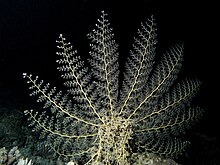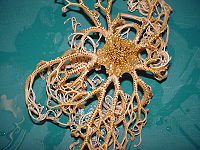Basket star
| Basketstars | |
|---|---|

| |
| Astroboa nuda basket star feeding at night in the Red Sea | |
| Scientific classification | |
| Kingdom: | Animalia |
| Phylum: | Echinodermata |
| Class: | Ophiuroidea |
| Order: | Phrynophiurida |
| Suborder: | Euryalina Lamarck, 1816 |
| Families | |
|
Asteronychidae | |
Basket stars are a taxon of brittle stars. They are treated as a suborder Euryalina[1] or order Euryalida.[2] Many of them have characteristic repeatedly branched arms. They generally live in deep sea habitats. However, they have been observed near 15 m or less in Plettenberg Bay, South Africa and less than 10 meters in Roatan, Honduras. In the wild they may live up to 35 years. They weigh up to 5 kilograms (11 lb). Like other echinoderms, basket stars lack blood and achieve gas exchange via their water vascular system.
The basket stars are the largest ophiuroids with Gorgonocephalus stimpsoni measuring up to 70 cm in arm length with a disk diameter of 14 cm.[3]
Systematics and phylogeny[]
The fossil record of this group is rather poor and only dates back to Carboniferous.[4] Basket stars are divided into the following families:
- Asteronychidae
- Asteroschematidae
- Gorgonocephalidae
- Euryalidae
Gallery[]

A basket star, located in an area known as "Star Wall", near Maori Bay, New Zealand at a depth of approximately 28 m.
Close-up of Astroboa nuda basket star arm

Basket star taken from the Atlantic Ocean
References[]
- ^ "Euryalina". Integrated Taxonomic Information System.
- ^ Smith, A.B.; Paterson, G.L.J. (1995). "Ophiuroid phylogeny and higher taxonomy: Morphological, molecular and palaeontological perspectives". Zool. J. Linn. Soc. 114.
- ^ Grzimek's Animal Life Encyclopedia. Vol. 1. Gale Cengage. 2003.
- ^ Clarkson, E.; Clarkson, E.N.K. (1998). Invertebrate Palaeontology and Evolution (4 ed.). Wiley-Blackwell.
External links[]
- Jo, Yeo Sam (16 October 2014). "Singapore angler catches basket star: 5 things to know about the sea creature". The Straits Times.
- Ophiuroidea
- Phrynophiurida
- Ophiuroidea stubs


